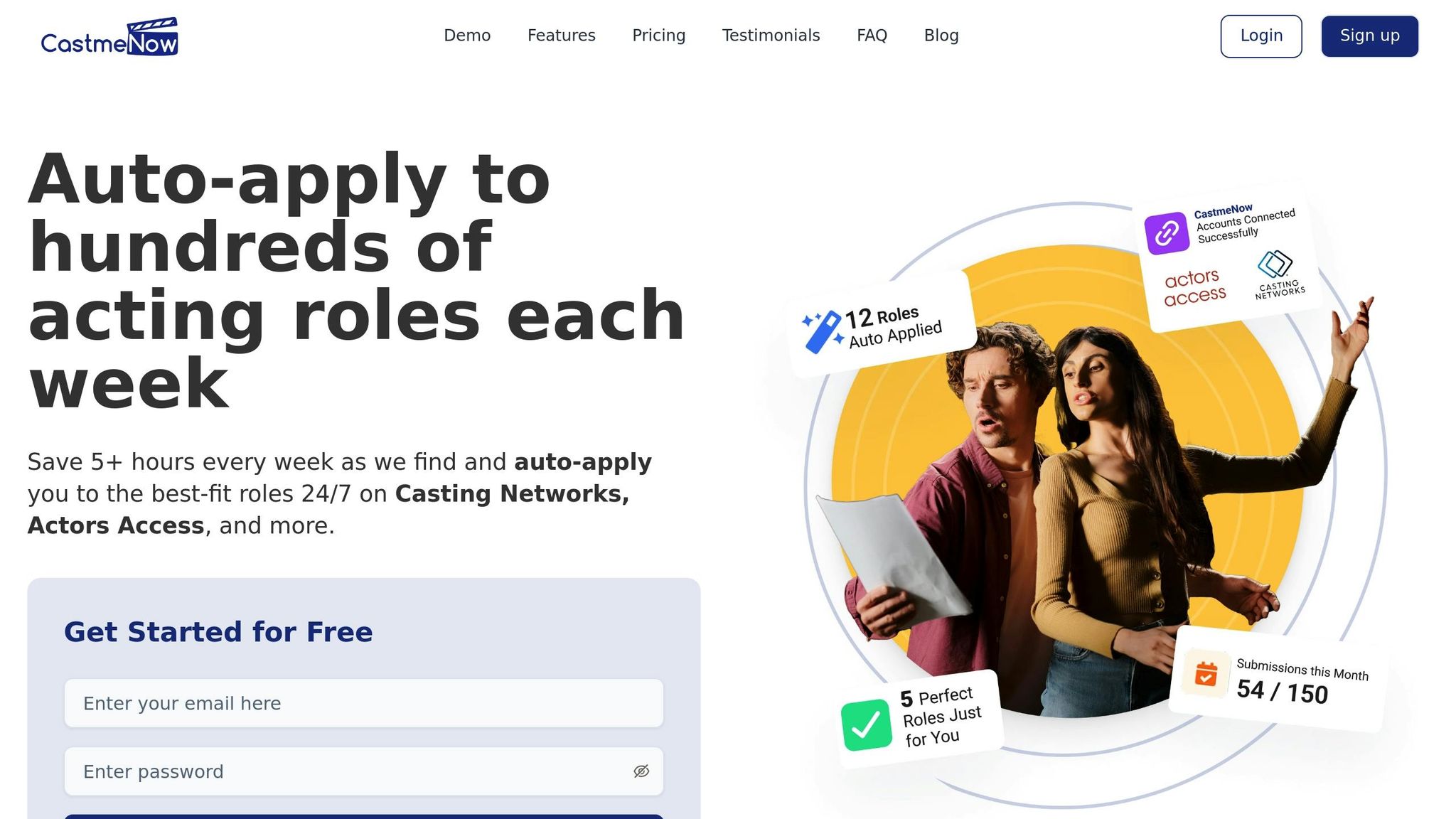Emerging Roles in 2025: Insights from Reports
Explore how automation and diversity initiatives are transforming acting roles in 2025, enhancing opportunities for performers in film, TV, and theater.

Actors in 2025 are using automation tools to save time and find more opportunities. Platforms like CastMeNow (CMN) allow performers to submit to over 80 roles weekly, freeing up hours for creative work. The entertainment industry is also evolving with technologies like VR/AR in film, interactive storytelling in TV, and hybrid performances in theater. Here's what you need to know:
- Automation Benefits: Tools like CMN save 5+ hours weekly and enable up to 150+ submissions per month for as low as $5/month.
- Industry Trends:
- Film: 40% of studio films now use VR/AR, requiring motion capture skills.
- TV: 68% of streaming originals feature interactive episodes.
- Theater: Hybrid performances blend live acting with AI and digital elements.
- Diversity Push: New guidelines require 35% diversity in roles, with more opportunities for multilingual and neurodiverse actors.
Quick Comparison of Media Trends:
| Media Type | Growth Rate | Key Skills | Notable Changes |
|---|---|---|---|
| Film | 15% | VR/AR, motion capture | Immersive tech, virtual environments |
| Television | 23% | Interactive storytelling | Real-time audience interaction |
| Theater | 9% | Hybrid performance skills | Blending live and digital performances |
Actors can thrive by combining automation tools with updated skills and profiles, staying ahead in this rapidly evolving industry.
AI Tools Every Actor Needs to Know in 2025
1. Media Industry Role Changes
The entertainment industry in 2025 is experiencing noticeable shifts across film, television, and theater. According to the Nielsen 2025 Media Trends Report, television is projected to see a 23% rise in roles, while film and theater are expected to grow by 15% and 9%, respectively. Let’s break down how these changes are shaping each sector.
In film, virtual reality (VR) and augmented reality (AR) are becoming standard. The Motion Picture Association of America’s Q1 2025 report notes that 40% of studio films now incorporate VR/AR technologies. For instance, Avatar 3 (2025) highlights this trend, employing over 80 specialized motion-capture actors for its underwater scenes. These roles demand skills like Vicon training certification and proficiency in green-screen acting. Director James Cameron explains:
"Actors must now perform for 360-degree cameras, not just traditional frames."
Television continues to evolve with the rise of streaming platforms, where interactive storytelling is becoming a dominant force. Parrot Analytics reports that 68% of streaming originals now include interactive episodes. A prime example is Amazon’s The Multiverse, which requires actors to portray multiple versions of their characters across parallel storylines.
Here’s a quick look at the trends across these sectors:
| Media Type | Growth Rate | Key Requirements | Notable Changes |
|---|---|---|---|
| Television | 23% | Interactive narrative, multi-camera skills | Branching storylines, real-time audience interaction |
| Film | 15% | VR/AR proficiency, motion capture certification | Acting in virtual environments, immersive tech integration |
| Theater | 9% | Digital stagecraft knowledge, hybrid performance skills | Blending live and digital elements, AI-enhanced productions |
Theater is embracing technology while staying true to its live roots. An Americans for the Arts survey found that 120 U.S. theaters have adopted hybrid technology since 2023. Director Ivo van Hove explains:
"Digital projections let us reimagine classics without losing live energy."
This fusion is evident in productions like the Ahmanson Theatre’s The Metaverse Macbeth, which combines live performers with AI-generated avatars.
Casting practices are also shifting toward greater inclusivity. The 2025 Academy of Motion Picture Arts and Sciences guidelines require 35% diversity in roles. Disney+’s Cultural Anthology Series emphasizes multilingual performers, while The Public Theater’s "Open Stage" initiative reserves half its roles for neurodiverse actors. These efforts reflect a broader push for equity alongside technological and narrative innovation.
However, these changes come with challenges. VR training programs cost around $2,500 per month, and competition is fierce - over 1,200 applicants vie for each interactive TV role on Casting Networks. While 73% of VR acting jobs are concentrated in Los Angeles and San Francisco, hybrid theater roles are more evenly spread, with 45% of opportunities in cities like Chicago and Austin. A 2025 UCLA School of Theater study found that 78% of audiences prefer hybrid performances, fueling the ongoing transformation of the acting landscape.
2. CastmeNow (Cast Me Now)

In 2025, the entertainment industry is embracing automation to simplify how actors discover and apply for roles. CastmeNow takes the hassle out of casting applications by automating submissions on platforms like Casting Networks and Actors Access. This shift reflects the industry's move toward digital tools that make role acquisition faster and more efficient.
CastmeNow uses an intelligent system to match actors with roles that fit their profiles. This allows actors to apply for far more opportunities than they could with manual submissions. Here's a snapshot of the platform's performance:
| Metric | Performance |
|---|---|
| Weekly Time Saved | 5+ hours |
| Average Weekly Submissions | 80+ roles |
| Response Time to New Roles | Within 2 hours (Basic Plan) |
| Monthly Submission Capacity | Up to 150 (Basic) / Unlimited (Unlimited) |
These numbers highlight how CastmeNow is reshaping the casting process.
Actor Kassan Harris shared his thoughts on the platform:
"In just 7 days I received over 10 media requests. And submitting to around 83 roles. Way more than what I would've been capable of doing manually."
CastmeNow provides two subscription options tailored to different needs. The Basic Plan, priced at $5 per month, includes essential automation features and allows up to 150 submissions each month. For $12 per month, the Unlimited Plan removes all limits, submitting applications to new roles as soon as they appear.
Benefits and Limitations
As automation continues to shape casting in 2025, understanding its advantages and challenges is crucial for actors adapting to this shift. Here's a breakdown based on actors' experiences:
| Aspect | Benefits | Limitations |
|---|---|---|
| Time Management | Streamlines the submission process, saving valuable time | Requires initial setup and regular profile updates |
| Role Access | Opens doors to over 80 opportunities weekly | Demands active profiles on connected platforms |
| Response Speed | Submissions processed within 2 hours (Basic) or instantly (Unlimited) | Relies on casting directors' review timelines |
| Cost Efficiency | Affordable plans from $5 to $12 per month | May require additional subscriptions to casting platforms |
| Submission Volume | Allows up to 150 submissions monthly (Basic) or unlimited (Unlimited) | Success depends on well-crafted, accurate profiles |
Automation has undeniably transformed how actors approach casting. Actor Gabbi Mack shared her experience:
"LOVE CastMeNow so far! In just a week I've been submitted for over 80 projects and have received more EcoCasts than I have in months!"
While automation simplifies submissions and boosts access to roles, actors must stay proactive. Keeping profiles updated and refining role preferences are essential to make the most of these tools. This blend of efficiency and effort helps actors tap into new opportunities in today’s fast-changing media landscape.
Key Takeaways
By 2025, succeeding in the acting world requires a smart mix of leveraging digital tools and managing roles effectively. Here’s what industry insights highlight:
Save Time While Boosting Submissions
Automated submission tools can save actors over 5 hours each week, giving them more time to focus on their craft. Actor Ian Mark notes how automating submissions allows him to dedicate more energy to creative pursuits. These tools not only increase the number of submissions but also speed up responses to casting calls, aligning with trends highlighted in earlier reports.
Smart Role Management
To thrive in the evolving casting landscape, actors should:
- Clearly define role preferences and ensure union status is accurate
- Keep casting profiles updated across multiple platforms
- Stay informed about industry trends and new opportunities
Affordable Tools for Growth
Automation tools offer a budget-friendly way to advance your career. Plans start at just $5 per month, with more comprehensive options available for $12 per month. Actor Olivia shares her positive experience:
"The site is working great! I've actually been overwhelmed with auditions from it and have recommended it to many friends."
The Digital Shift in Casting
The move toward digital automation is reshaping how casting works. Actors who embrace these tools can submit to more opportunities while freeing up time to improve their skills and build their personal brand. These insights highlight how actors can fine-tune their profiles and take advantage of new opportunities in the industry.
FAQs
How can actors prepare for the growing demand for VR and AR skills in the film industry by 2025?
To stay ahead in the evolving film industry, actors should focus on developing skills tailored to virtual reality (VR) and augmented reality (AR) productions. These technologies often require proficiency in motion capture, voice acting, and understanding how to perform in immersive, interactive environments.
Actors can prepare by:
- Taking workshops or classes on motion capture and digital performance techniques.
- Gaining experience with VR/AR projects, such as independent or experimental productions.
- Learning to adapt performances for environments where traditional sets or cameras may not be present.
Platforms like CastmeNow can help actors stay updated on emerging opportunities in these areas, ensuring they don’t miss roles that align with their goals. By staying proactive and adaptable, actors can position themselves for success in this exciting and growing field.
How can actors use automation tools like CastMeNow to find more opportunities and save time?
Actors can make the most of automation tools like CastMeNow by connecting their casting profiles, such as Casting Networks and Actors Access, and setting their role preferences. Once set up, the tool automatically applies to relevant roles 24/7, saving actors significant time and effort.
By streamlining the application process, actors can focus on honing their craft and preparing for auditions while ensuring they never miss out on opportunities that match their profile. With flexible plans, including a free trial, CastMeNow offers solutions for actors at every stage of their career.
How are new diversity initiatives shaping opportunities for multilingual and neurodiverse actors in 2025?
Emerging diversity initiatives in 2025 are creating more inclusive casting practices, opening doors for multilingual and neurodiverse actors. Industry reports highlight a growing demand for authentic representation across film, TV, and theater, with casting directors actively seeking talent that reflects diverse backgrounds and experiences.
These changes align with broader trends in media, where audiences value stories that authentically represent different cultures and perspectives. Platforms like CastmeNow can help actors navigate this evolving landscape by automating applications for roles that match their unique profiles, ensuring they don’t miss out on opportunities tailored to their skills and identities.

